Steve,
I think you must have doubled the speed of sound unintentionally, or perhaps I am mistaken?
Anyway, who cares.
Quite right. 15ms is 5 metres spatially. Not 10. Speed of sound 330 metres per second. It ties in with a 30Hz 8" bass in reflex. Half a wavelength delay from the Helmholtz resonance. Er, I think. 😱
Glad someone is paying attention.
Last edited:
Here is an example of an erudite rendition of Pure Physics Theory who, in the last sentence, is oblivious to the reality that the wide band condition he specifies is met by approximately 0% of subs in the known universe*.
B.
*OK, I know there is a driver with a resonance at 10 Hz if you can find it
You completely missed the point of that post.
Since the effects of rooms were brought up here are some simulation for a monopole, dipole and cardioid woofer with 20 Hz, Q=0.5 HP and 120 Hz, B4 LP response. The green traces are the impulse response of the woofer w/o room effects. The blue is what you get at the listening position. "Aligned" means the axis of the dipole or cardioid is aligned with a room axis, front to rear.
Mono pole
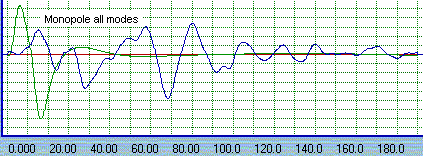
Dipole
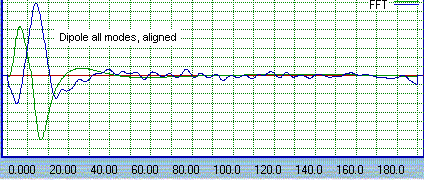
Cardioid
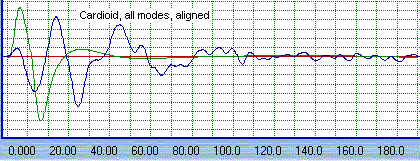
If you angle the dipole and cardioid at 45 degrees (toed in) this is what you get.
Dipole 45*
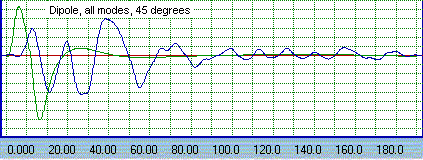
Cardioid 45*
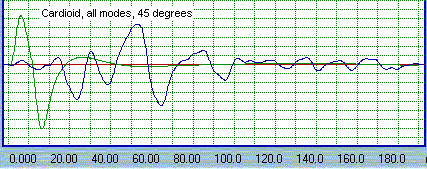
This all looks very interesting, but these are simulations.
How about some real world measurements...
P.s. ever been in a room that has the RT60 times of those simulations? They are not comfortable at all.
You completely missed the point of that post.
That's an unhelpful reply. Can you explain?
B.
like I said, the "fastest" ( dont ask me it just sounded super fast and clean , lifelike) bass I have ever heard was a totally limp, no tension, and high mass, planer magnetic dipole running full range, listening on axis. It was like a live drum kit in the room.
Also played with seal box woofers with mass added to get 5 Hz fs or lower. sense of depth and linearity was humbling, as was the ultra low sensitivity ha
Also played with seal box woofers with mass added to get 5 Hz fs or lower. sense of depth and linearity was humbling, as was the ultra low sensitivity ha
@lowmass - Interested in your technique for adding mass to an existing driver. Please explain how to if you can.
Pushing against a 5 Hz resonance, all normal bass audio frequencies will be well integrated and the phase shift should be more or less a constant.
Such a technique may be good to have in ones back pocket. I have a pair of 18"s I wouldnt mind lowering the resonance of; only choice I have is to can them and buy new drivers with the desired properties.
All the ways I can think of to add mass would probably just ruin the driver completely and hence, a waste of time and two more pieces of trash for the world....
Pushing against a 5 Hz resonance, all normal bass audio frequencies will be well integrated and the phase shift should be more or less a constant.
Such a technique may be good to have in ones back pocket. I have a pair of 18"s I wouldnt mind lowering the resonance of; only choice I have is to can them and buy new drivers with the desired properties.
All the ways I can think of to add mass would probably just ruin the driver completely and hence, a waste of time and two more pieces of trash for the world....
The problem with the passive approach is that with a dipole woofer and the 6dB/oct roll off you can only flatten the response with attenuation. Using the dipole = monopole (d=m) frequency as a reference, if you want to extend the bass 2 octave below the d=m frequency you need to actively increase the gain below the d=m and attenuate above that frequency at 6dB/oct. This means the net effect is that the system sensitivity for the midrange and up will be that of the woofer's monopole sensitivity. But if you do that passively you can only attenuate which means the d=m point will be attenuated by 12 dB and the midrange and up will also have to be attenuated which wastes a lot of amplifier voltage swing. The way around it, as you often see in passive dipole systems is numerous, large, high sensitivity woofers on large baffles so that after attenuation the sensitivity at the d=m frequency is still in the 88 to 90 db/volt range.
The next problem is that due to the large baffles such system don't really behave as dipoles at higher frequencies (midrange and mid bass) hence they are typically called open baffle systems. That doesn't mean they don't sound good. If you look at the Ultimate Open Baffle thread you can see that just about any configuration of a group of drivers on a piece of plywood can be made to sound good to someone's ear. 🙂
yes, a large open baffle could be something for me to consider, thank you
The easiest way to add mass to a driver is to shape lead wire into a ring that just fits around where the voice coil former joins the cone and glue it there. You will likely have to remove the dust cap to do so. Choose a gauge of wire to give the desired mass. Sub drivers in cheap home theatre systems commonly have a disc of heavy cardboard glued onto the cone instead of a dust cap.
- Home
- Loudspeakers
- Multi-Way
- Back to Transients. Understanding "Q" and myths of bass